sensor FIAT DUCATO BASE CAMPER 2015 Owner handbook (in English)
[x] Cancel search | Manufacturer: FIAT, Model Year: 2015, Model line: DUCATO BASE CAMPER, Model: FIAT DUCATO BASE CAMPER 2015Pages: 367, PDF Size: 19.73 MB
Page 10 of 367
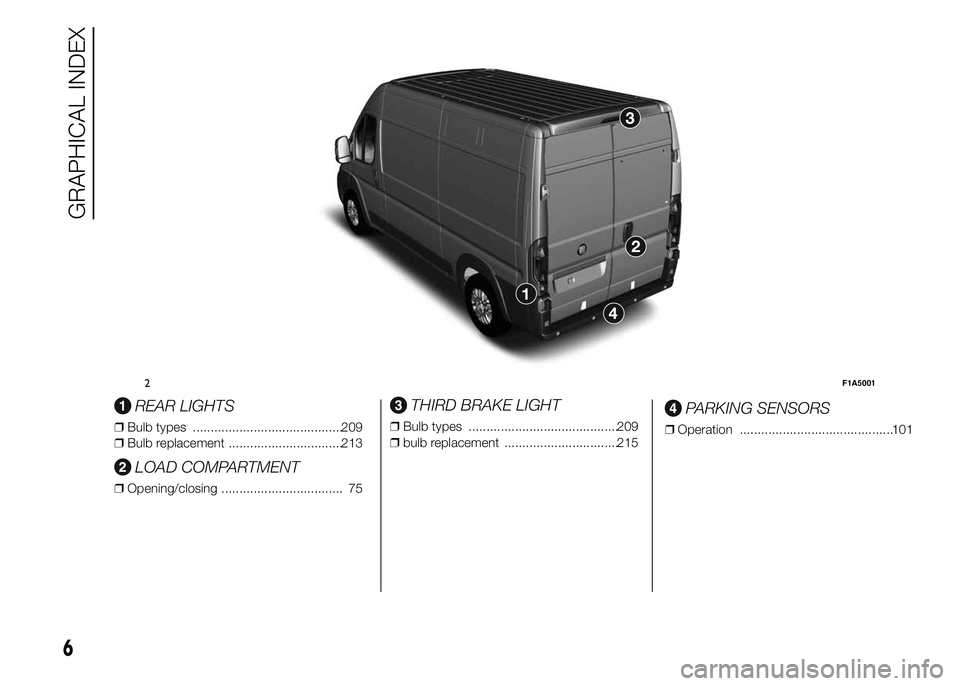
.
REAR LIGHTS
❒Bulb types ..........................................209
❒Bulb replacement ................................213
LOAD COMPARTMENT
❒Opening/closing .................................. 75
THIRD BRAKE LIGHT
❒Bulb types ..........................................209
❒bulb replacement ................................215
PARKING SENSORS
❒Operation ...........................................101
2F1A5001
6
GRAPHICAL INDEX
Page 13 of 367
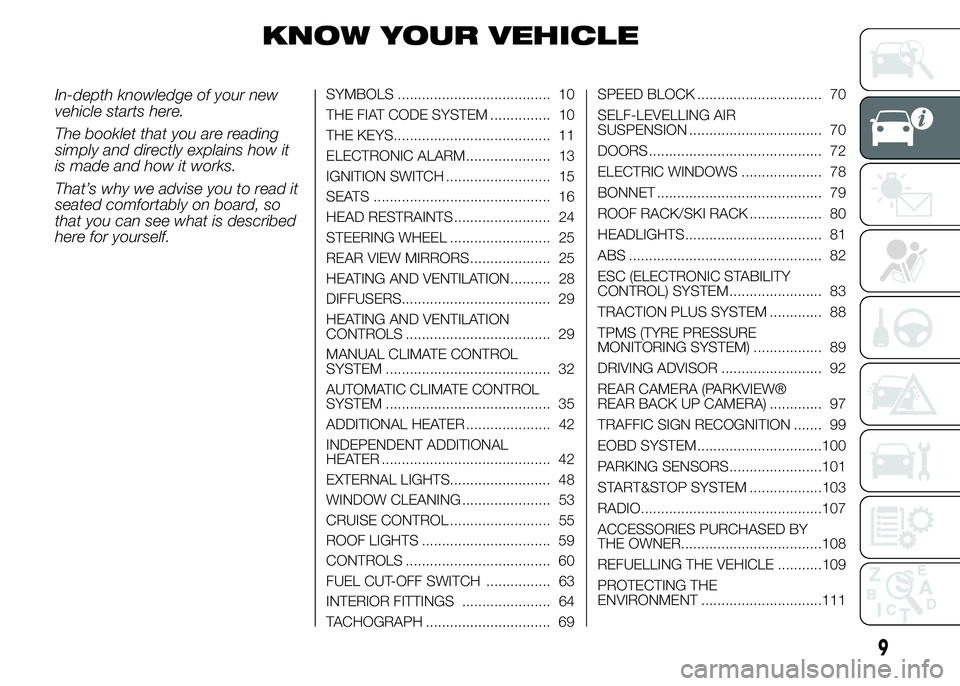
KNOW YOUR VEHICLE
In-depth knowledge of your new
vehicle starts here.
The booklet that you are reading
simply and directly explains how it
is made and how it works.
That’s why we advise you to read it
seated comfortably on board, so
that you can see what is described
here for yourself.SYMBOLS ...................................... 10
THE FIAT CODE SYSTEM ............... 10
THE KEYS....................................... 11
ELECTRONIC ALARM..................... 13
IGNITION SWITCH .......................... 15
SEATS ............................................ 16
HEAD RESTRAINTS ........................ 24
STEERING WHEEL ......................... 25
REAR VIEW MIRRORS .................... 25
HEATING AND VENTILATION.......... 28
DIFFUSERS..................................... 29
HEATING AND VENTILATION
CONTROLS .................................... 29
MANUAL CLIMATE CONTROL
SYSTEM ......................................... 32
AUTOMATIC CLIMATE CONTROL
SYSTEM ......................................... 35
ADDITIONAL HEATER ..................... 42
INDEPENDENT ADDITIONAL
HEATER .......................................... 42
EXTERNAL LIGHTS......................... 48
WINDOW CLEANING ...................... 53
CRUISE CONTROL ......................... 55
ROOF LIGHTS ................................ 59
CONTROLS .................................... 60
FUEL CUT-OFF SWITCH ................ 63
INTERIOR FITTINGS ...................... 64
TACHOGRAPH ............................... 69SPEED BLOCK ............................... 70
SELF-LEVELLING AIR
SUSPENSION ................................. 70
DOORS ........................................... 72
ELECTRIC WINDOWS .................... 78
BONNET ......................................... 79
ROOF RACK/SKI RACK .................. 80
HEADLIGHTS.................................. 81
ABS ................................................ 82
ESC (ELECTRONIC STABILITY
CONTROL) SYSTEM ....................... 83
TRACTION PLUS SYSTEM ............. 88
TPMS (TYRE PRESSURE
MONITORING SYSTEM) ................. 89
DRIVING ADVISOR ......................... 92
REAR CAMERA (PARKVIEW®
REAR BACK UP CAMERA) ............. 97
TRAFFIC SIGN RECOGNITION ....... 99
EOBD SYSTEM...............................100
PARKING SENSORS.......................101
START&STOP SYSTEM ..................103
RADIO.............................................107
ACCESSORIES PURCHASED BY
THE OWNER...................................108
REFUELLING THE VEHICLE ...........109
PROTECTING THE
ENVIRONMENT ..............................111
9
Page 39 of 367
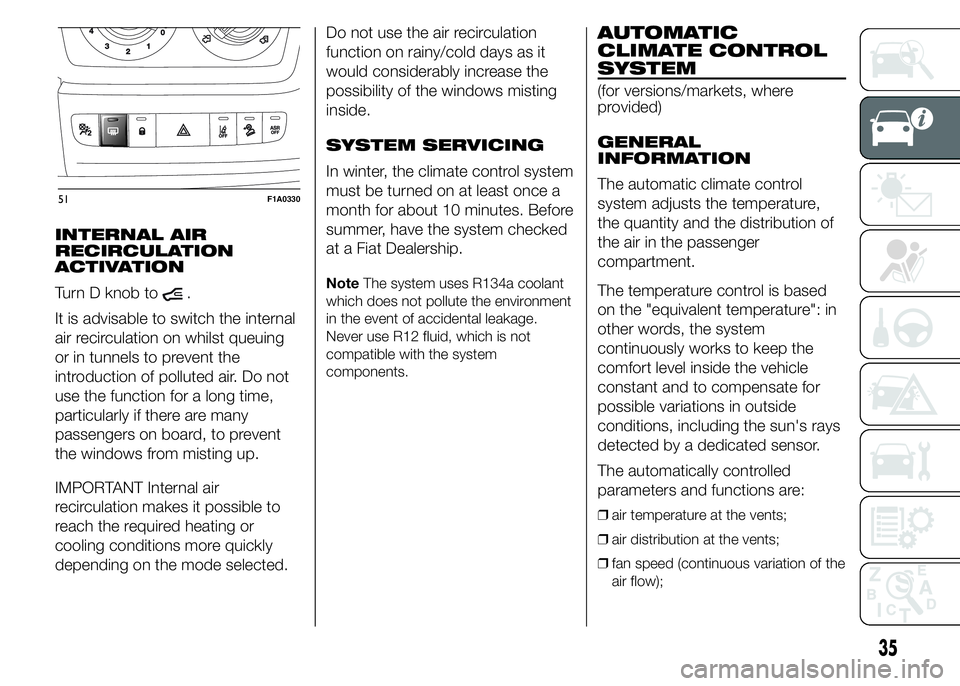
INTERNAL AIR
RECIRCULATION
ACTIVATION
Turn D knob to
.
It is advisable to switch the internal
air recirculation on whilst queuing
or in tunnels to prevent the
introduction of polluted air. Do not
use the function for a long time,
particularly if there are many
passengers on board, to prevent
the windows from misting up.
IMPORTANT Internal air
recirculation makes it possible to
reach the required heating or
cooling conditions more quickly
depending on the mode selected.Do not use the air recirculation
function on rainy/cold days as it
would considerably increase the
possibility of the windows misting
inside.
SYSTEM SERVICING
In winter, the climate control system
must be turned on at least once a
month for about 10 minutes. Before
summer, have the system checked
at a Fiat Dealership.NoteThe system uses R134a coolant
which does not pollute the environment
in the event of accidental leakage.
Never use R12 fluid, which is not
compatible with the system
components.
AUTOMATIC
CLIMATE CONTROL
SYSTEM
(for versions/markets, where
provided)
GENERAL
INFORMATION
The automatic climate control
system adjusts the temperature,
the quantity and the distribution of
the air in the passenger
compartment.
The temperature control is based
on the "equivalent temperature": in
other words, the system
continuously works to keep the
comfort level inside the vehicle
constant and to compensate for
possible variations in outside
conditions, including the sun's rays
detected by a dedicated sensor.
The automatically controlled
parameters and functions are:
❒air temperature at the vents;
❒air distribution at the vents;
❒fan speed (continuous variation of the
air flow);
51F1A0330
35
Page 55 of 367
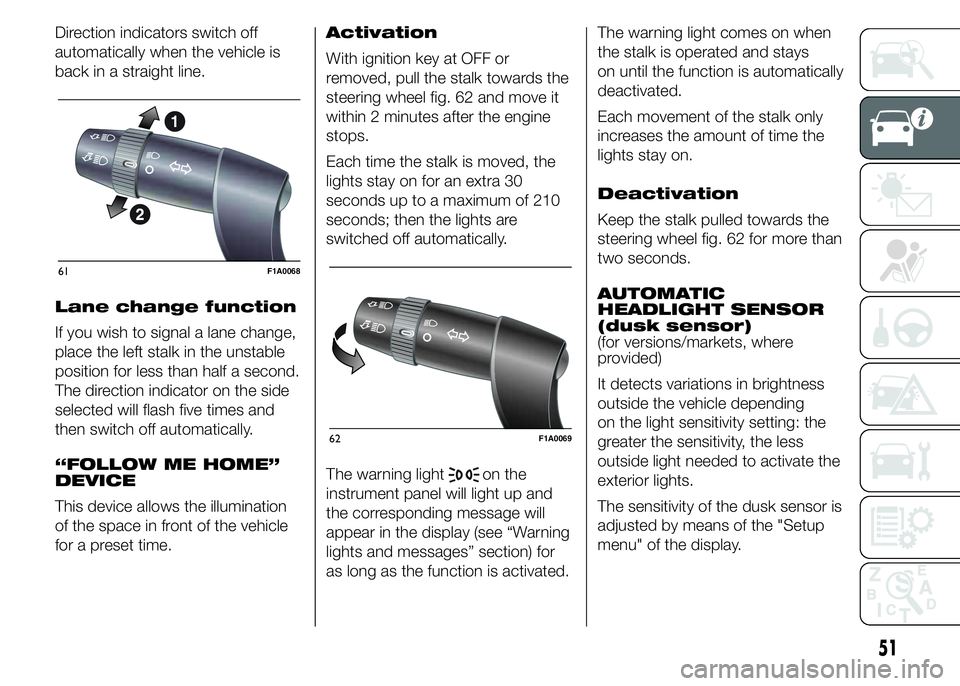
Direction indicators switch off
automatically when the vehicle is
back in a straight line.
Lane change function
If you wish to signal a lane change,
place the left stalk in the unstable
position for less than half a second.
The direction indicator on the side
selected will flash five times and
then switch off automatically.
“FOLLOW ME HOME”
DEVICE
This device allows the illumination
of the space in front of the vehicle
for a preset time.Activation
With ignition key at OFF or
removed, pull the stalk towards the
steering wheel fig. 62 and move it
within 2 minutes after the engine
stops.
Each time the stalk is moved, the
lights stay on for an extra 30
seconds up to a maximum of 210
seconds; then the lights are
switched off automatically.
The warning light
on the
instrument panel will light up and
the corresponding message will
appear in the display (see “Warning
lights and messages” section) for
as long as the function is activated.The warning light comes on when
the stalk is operated and stays
on until the function is automatically
deactivated.
Each movement of the stalk only
increases the amount of time the
lights stay on.
Deactivation
Keep the stalk pulled towards the
steering wheel fig. 62 for more than
two seconds.
AUTOMATIC
HEADLIGHT SENSOR
(dusk sensor)
(for versions/markets, where
provided)
It detects variations in brightness
outside the vehicle depending
on the light sensitivity setting: the
greater the sensitivity, the less
outside light needed to activate the
exterior lights.
The sensitivity of the dusk sensor is
adjusted by means of the "Setup
menu" of the display.
61F1A0068
62F1A0069
51
Page 56 of 367
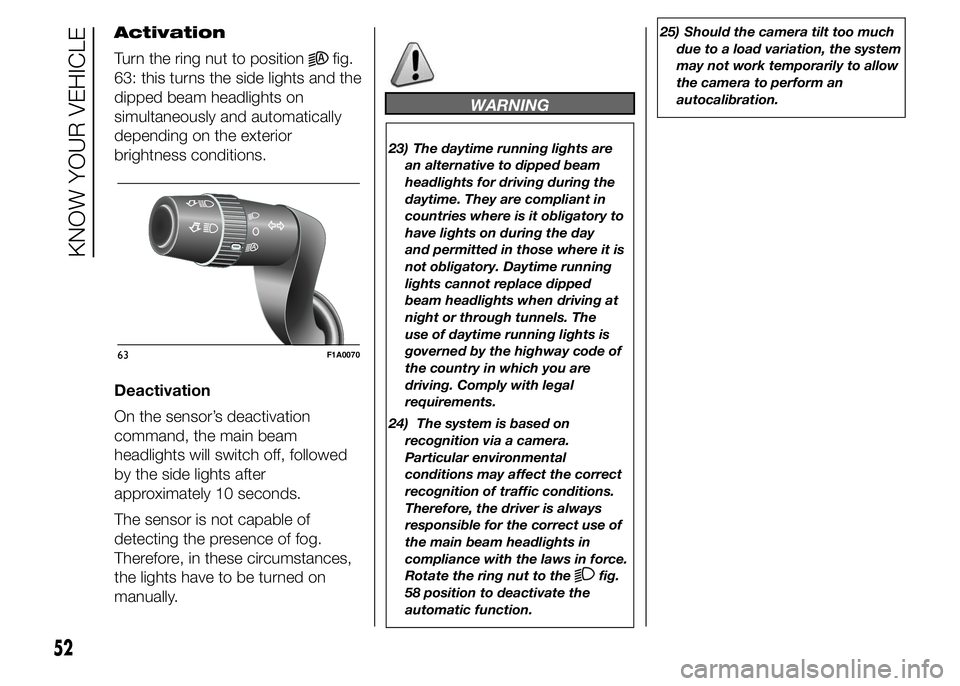
Activation
Turn the ring nut to position
fig.
63: this turns the side lights and the
dipped beam headlights on
simultaneously and automatically
depending on the exterior
brightness conditions.
Deactivation
On the sensor’s deactivation
command, the main beam
headlights will switch off, followed
by the side lights after
approximately 10 seconds.
The sensor is not capable of
detecting the presence of fog.
Therefore, in these circumstances,
the lights have to be turned on
manually.
WARNING
23) The daytime running lights are
an alternative to dipped beam
headlights for driving during the
daytime. They are compliant in
countries where is it obligatory to
have lights on during the day
and permitted in those where it is
not obligatory. Daytime running
lights cannot replace dipped
beam headlights when driving at
night or through tunnels. The
use of daytime running lights is
governed by the highway code of
the country in which you are
driving. Comply with legal
requirements.
24) The system is based on
recognition via a camera.
Particular environmental
conditions may affect the correct
recognition of traffic conditions.
Therefore, the driver is always
responsible for the correct use of
the main beam headlights in
compliance with the laws in force.
Rotate the ring nut to the
fig.
58 position to deactivate the
automatic function.25) Should the camera tilt too much
due to a load variation, the system
may not work temporarily to allow
the camera to perform an
autocalibration.
63F1A0070
52
KNOW YOUR VEHICLE
Page 57 of 367
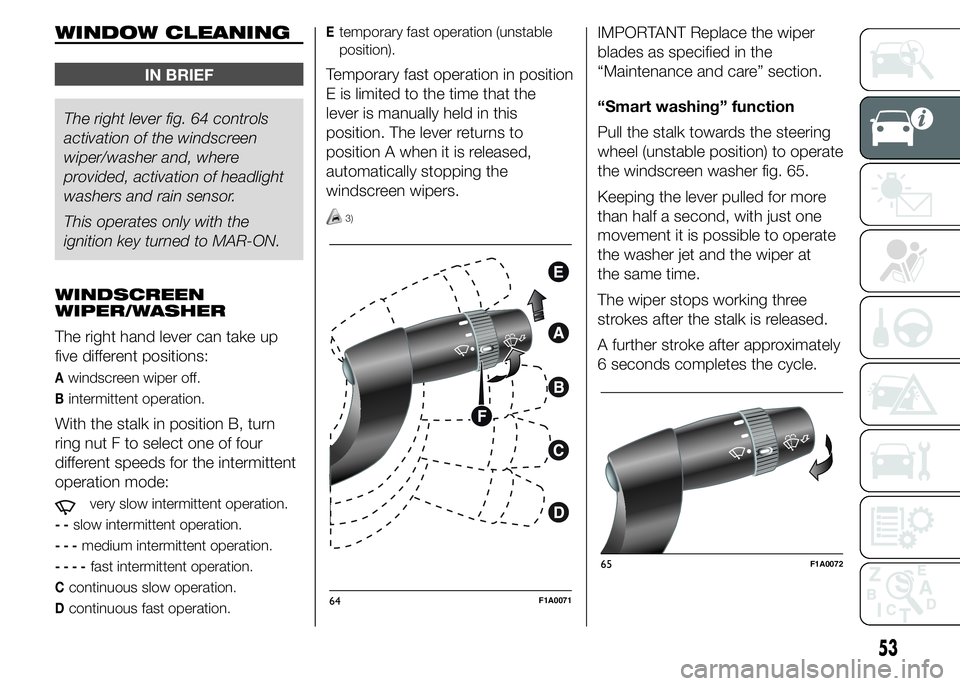
WINDOW CLEANING
IN BRIEF
The right lever fig. 64 controls
activation of the windscreen
wiper/washer and, where
provided, activation of headlight
washers and rain sensor.
This operates only with the
ignition key turned to MAR-ON.
WINDSCREEN
WIPER/WASHER
The right hand lever can take up
five different positions:
Awindscreen wiper off.
Bintermittent operation.
With the stalk in position B, turn
ring nut F to select one of four
different speeds for the intermittent
operation mode:
very slow intermittent operation.
--slow intermittent operation.
---medium intermittent operation.
----fast intermittent operation.
Ccontinuous slow operation.
Dcontinuous fast operation.
Etemporary fast operation (unstable
position).
Temporary fast operation in position
E is limited to the time that the
lever is manually held in this
position. The lever returns to
position A when it is released,
automatically stopping the
windscreen wipers.
3)
IMPORTANT Replace the wiper
blades as specified in the
“Maintenance and care” section.
“Smart washing” function
Pull the stalk towards the steering
wheel (unstable position) to operate
the windscreen washer fig. 65.
Keeping the lever pulled for more
than half a second, with just one
movement it is possible to operate
the washer jet and the wiper at
the same time.
The wiper stops working three
strokes after the stalk is released.
A further stroke after approximately
6 seconds completes the cycle.
64F1A0071
65F1A0072
53
Page 58 of 367
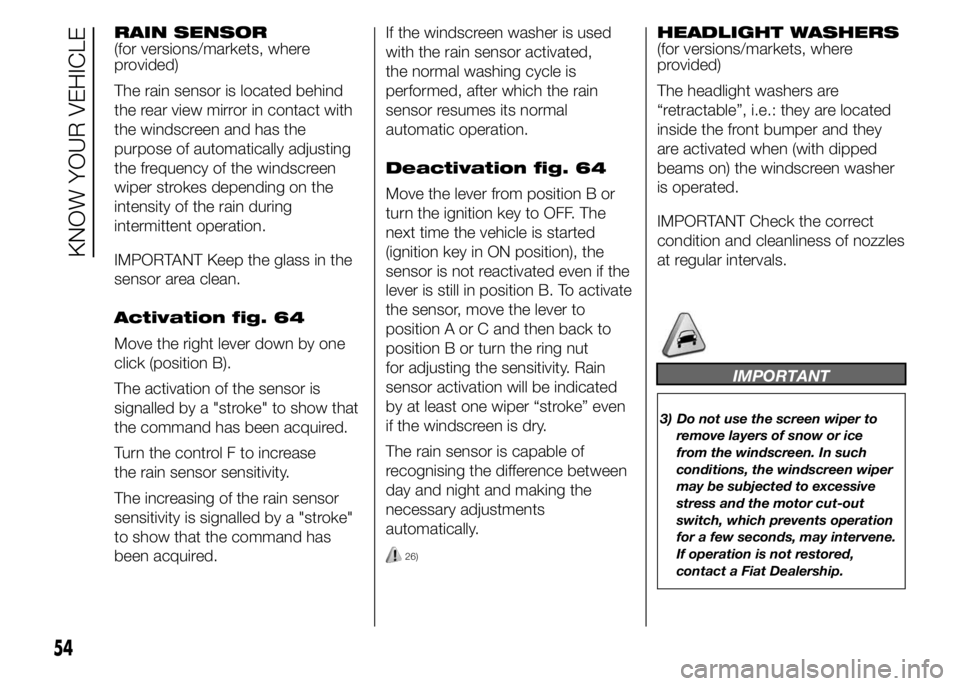
RAIN SENSOR
(for versions/markets, where
provided)
The rain sensor is located behind
the rear view mirror in contact with
the windscreen and has the
purpose of automatically adjusting
the frequency of the windscreen
wiper strokes depending on the
intensity of the rain during
intermittent operation.
IMPORTANT Keep the glass in the
sensor area clean.
Activation fig. 64
Move the right lever down by one
click (position B).
The activation of the sensor is
signalled by a "stroke" to show that
the command has been acquired.
Turn the control F to increase
the rain sensor sensitivity.
The increasing of the rain sensor
sensitivity is signalled by a "stroke"
to show that the command has
been acquired.If the windscreen washer is used
with the rain sensor activated,
the normal washing cycle is
performed, after which the rain
sensor resumes its normal
automatic operation.
Deactivation fig. 64
Move the lever from position B or
turn the ignition key to OFF. The
next time the vehicle is started
(ignition key in ON position), the
sensor is not reactivated even if the
lever is still in position B. To activate
the sensor, move the lever to
position A or C and then back to
position B or turn the ring nut
for adjusting the sensitivity. Rain
sensor activation will be indicated
by at least one wiper “stroke” even
if the windscreen is dry.
The rain sensor is capable of
recognising the difference between
day and night and making the
necessary adjustments
automatically.
26)
HEADLIGHT WASHERS
(for versions/markets, where
provided)
The headlight washers are
“retractable”, i.e.: they are located
inside the front bumper and they
are activated when (with dipped
beams on) the windscreen washer
is operated.
IMPORTANT Check the correct
condition and cleanliness of nozzles
at regular intervals.
IMPORTANT
3) Do not use the screen wiper to
remove layers of snow or ice
from the windscreen. In such
conditions, the windscreen wiper
may be subjected to excessive
stress and the motor cut-out
switch, which prevents operation
for a few seconds, may intervene.
If operation is not restored,
contact a Fiat Dealership.
54
KNOW YOUR VEHICLE
Page 81 of 367
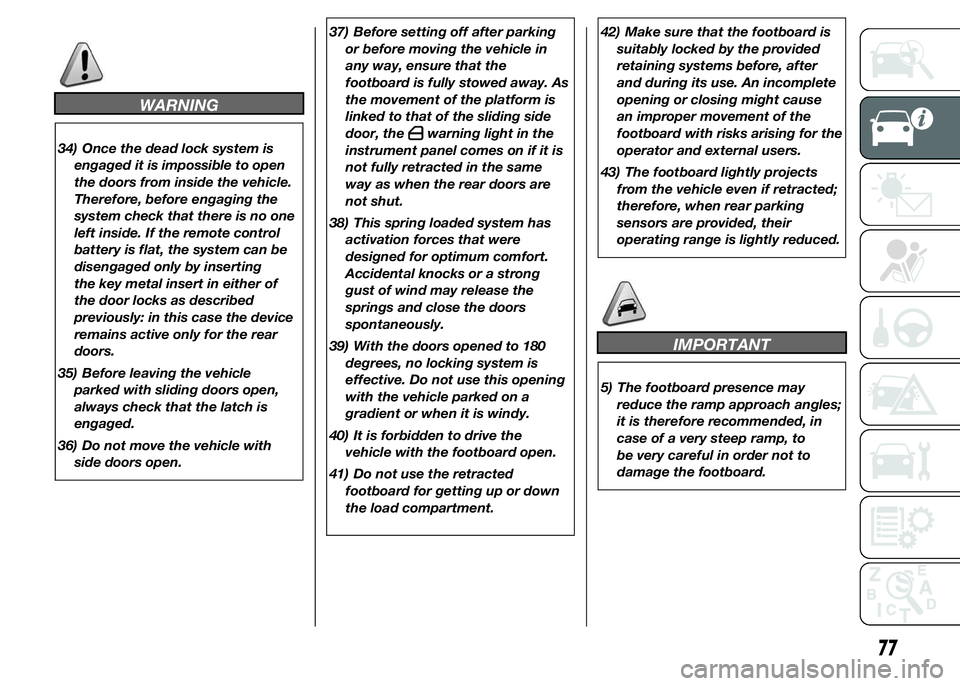
WARNING
34) Once the dead lock system is
engaged it is impossible to open
the doors from inside the vehicle.
Therefore, before engaging the
system check that there is no one
left inside. If the remote control
battery is flat, the system can be
disengaged only by inserting
the key metal insert in either of
the door locks as described
previously: in this case the device
remains active only for the rear
doors.
35) Before leaving the vehicle
parked with sliding doors open,
always check that the latch is
engaged.
36) Do not move the vehicle with
side doors open.37) Before setting off after parking
or before moving the vehicle in
any way, ensure that the
footboard is fully stowed away. As
the movement of the platform is
linked to that of the sliding side
door, thewarning light in the
instrument panel comes on if it is
not fully retracted in the same
way as when the rear doors are
not shut.
38) This spring loaded system has
activation forces that were
designed for optimum comfort.
Accidental knocks or a strong
gust of wind may release the
springs and close the doors
spontaneously.
39) With the doors opened to 180
degrees, no locking system is
effective. Do not use this opening
with the vehicle parked on a
gradient or when it is windy.
40) It is forbidden to drive the
vehicle with the footboard open.
41) Do not use the retracted
footboard for getting up or down
the load compartment.42) Make sure that the footboard is
suitably locked by the provided
retaining systems before, after
and during its use. An incomplete
opening or closing might cause
an improper movement of the
footboard with risks arising for the
operator and external users.
43) The footboard lightly projects
from the vehicle even if retracted;
therefore, when rear parking
sensors are provided, their
operating range is lightly reduced.
IMPORTANT
5) The footboard presence may
reduce the ramp approach angles;
it is therefore recommended, in
case of a very steep ramp, to
be very careful in order not to
damage the footboard.
77
Page 87 of 367
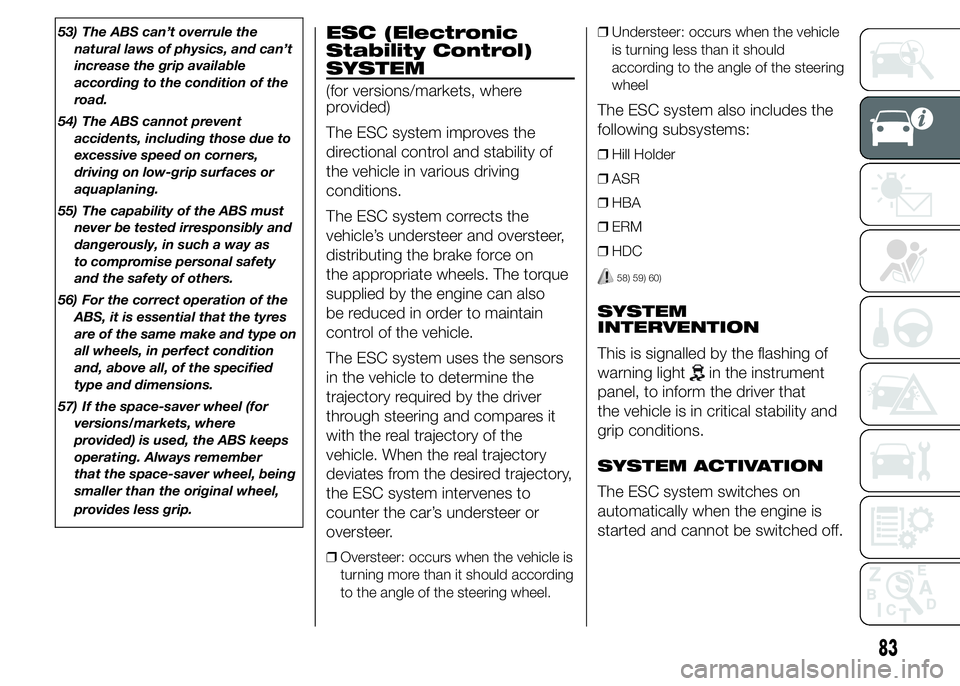
53) The ABS can’t overrule the
natural laws of physics, and can’t
increase the grip available
according to the condition of the
road.
54) The ABS cannot prevent
accidents, including those due to
excessive speed on corners,
driving on low-grip surfaces or
aquaplaning.
55) The capability of the ABS must
never be tested irresponsibly and
dangerously, in such a way as
to compromise personal safety
and the safety of others.
56) For the correct operation of the
ABS, it is essential that the tyres
are of the same make and type on
all wheels, in perfect condition
and, above all, of the specified
type and dimensions.
57) If the space-saver wheel (for
versions/markets, where
provided) is used, the ABS keeps
operating. Always remember
that the space-saver wheel, being
smaller than the original wheel,
provides less grip.ESC (Electronic
Stability Control)
SYSTEM
(for versions/markets, where
provided)
The ESC system improves the
directional control and stability of
the vehicle in various driving
conditions.
The ESC system corrects the
vehicle’s understeer and oversteer,
distributing the brake force on
the appropriate wheels. The torque
supplied by the engine can also
be reduced in order to maintain
control of the vehicle.
The ESC system uses the sensors
in the vehicle to determine the
trajectory required by the driver
through steering and compares it
with the real trajectory of the
vehicle. When the real trajectory
deviates from the desired trajectory,
the ESC system intervenes to
counter the car’s understeer or
oversteer.
❒Oversteer: occurs when the vehicle is
turning more than it should according
to the angle of the steering wheel.❒Understeer: occurs when the vehicle
is turning less than it should
according to the angle of the steering
wheel
The ESC system also includes the
following subsystems:
❒Hill Holder
❒ASR
❒HBA
❒ERM
❒HDC
58) 59) 60)
SYSTEM
INTERVENTION
This is signalled by the flashing of
warning light
in the instrument
panel, to inform the driver that
the vehicle is in critical stability and
grip conditions.
SYSTEM ACTIVATION
The ESC system switches on
automatically when the engine is
started and cannot be switched off.
83
Page 94 of 367
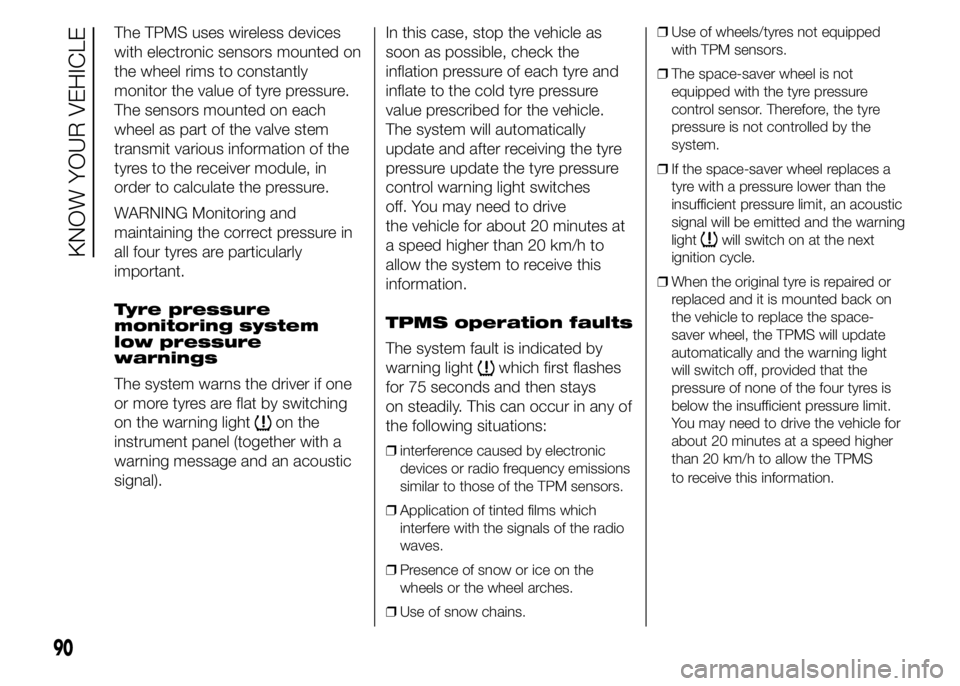
The TPMS uses wireless devices
with electronic sensors mounted on
the wheel rims to constantly
monitor the value of tyre pressure.
The sensors mounted on each
wheel as part of the valve stem
transmit various information of the
tyres to the receiver module, in
order to calculate the pressure.
WARNING Monitoring and
maintaining the correct pressure in
all four tyres are particularly
important.
Tyre pressure
monitoring system
low pressure
warnings
The system warns the driver if one
or more tyres are flat by switching
on the warning light
on the
instrument panel (together with a
warning message and an acoustic
signal).In this case, stop the vehicle as
soon as possible, check the
inflation pressure of each tyre and
inflate to the cold tyre pressure
value prescribed for the vehicle.
The system will automatically
update and after receiving the tyre
pressure update the tyre pressure
control warning light switches
off. You may need to drive
the vehicle for about 20 minutes at
a speed higher than 20 km/h to
allow the system to receive this
information.
TPMS operation faults
The system fault is indicated by
warning light
which first flashes
for 75 seconds and then stays
on steadily. This can occur in any of
the following situations:
❒interference caused by electronic
devices or radio frequency emissions
similar to those of the TPM sensors.
❒Application of tinted films which
interfere with the signals of the radio
waves.
❒Presence of snow or ice on the
wheels or the wheel arches.
❒Use of snow chains.❒Use of wheels/tyres not equipped
with TPM sensors.
❒The space-saver wheel is not
equipped with the tyre pressure
control sensor. Therefore, the tyre
pressure is not controlled by the
system.
❒If the space-saver wheel replaces a
tyre with a pressure lower than the
insufficient pressure limit, an acoustic
signal will be emitted and the warning
light
will switch on at the next
ignition cycle.
❒When the original tyre is repaired or
replaced and it is mounted back on
the vehicle to replace the space-
saver wheel, the TPMS will update
automatically and the warning light
will switch off, provided that the
pressure of none of the four tyres is
below the insufficient pressure limit.
You may need to drive the vehicle for
about 20 minutes at a speed higher
than 20 km/h to allow the TPMS
to receive this information.
90
KNOW YOUR VEHICLE